Arc’teryx Sabre LT Jacket
Reviewer: 5’8”, 155 lbs
Size Tested: Medium
Blister’s Measured Weight: 626 grams
Materials: 3L Gore-Tex w/ C-Knit Backer & 80-denier nylon face fabric
Stated Features:
- Hood w/ laminated brim and glove-friendly hood adjusters
- WaterTight™ external zippers
- WaterTight™ Vislon front zip
- RS™ (Rain Shield) pocket zipper sliders
- WaterTight™ pit zippers angled for easy access while wearing a pack
- Laminated die-cut Velcro® cuff adjusters reduce bulk, and won’t catch or tear off
- Large cuffs to fit over gloves
- Adjustable hem drawcord
- Slide ‘n Loc™ snap closures enable certain jackets to be fastened to ski pants to prevent snow entry
- Powder skirt with stretch panel and gripper elastic
- Hidden Recco® reflector
Pockets:
- 2 exterior handwarmer (zippered)
- 1 exterior chest (zippered)
- 1 exterior bicep (zippered)
- 1 interior chest (zippered)
- 1 interior drop-in (elastic)
MSRP: $649
Test Locations: Crested Butte & Gunnison, CO
Days Tested: ~15
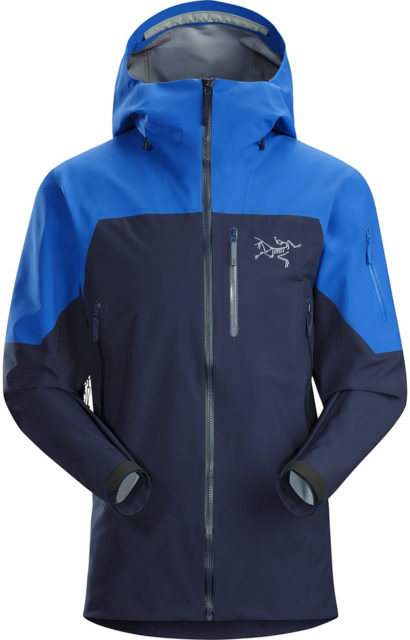
Intro
The Arc’teryx Sabre Jacket is one of my all-time favorite inbounds ski jackets. It’s pretty big, burly, and has all the features I want for skiing in the resort.
But the Sabre is also pretty warm for a shell, and it’s quite stiff and not as comfortable as some of the newer, more supple hard shells on the market.
To account for this, Arc’teryx recently released the Sabre LT Jacket. It’s a lighter, softer, and more comfortable version of the standard Sabre and is designed to cater to skiers that spend their time both inside and outside of the resort. So how different is the Sabre LT, how does it compare to other ski / snowboard shells out there, and who should be considering it?
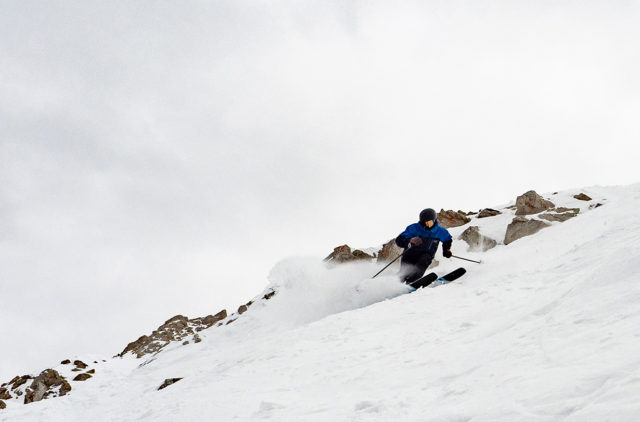
Fit
The Sabre LT is a bit longer and roomier than many of Arc’teryx’s other shells, though the Sabre LT’s cut is still on the more moderate side when compared to the entire market. I used the Sabre LT Jacket in my standard size of Medium (I’m 5’8”, 155 lbs), and it fits me very well.
The Sabre LT Jacket isn’t as long as bigger, “freeride-fit” shells like the Open Wear Open One 3L Shell and Strafe Pyramid Jacket, but the Sabre LT Jacket is notably longer than the Arc’teryx Alpha FL Jacket and Outdoor Research Hemispheres Jacket.
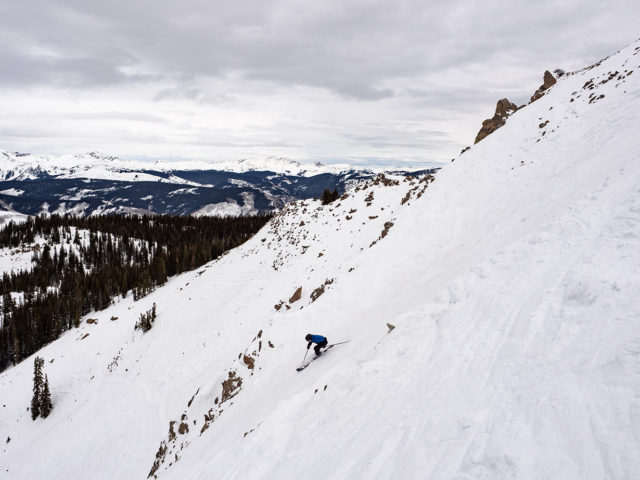
In the Sabre LT Jacket, I have plenty of room to add a base layer and puffy mid layer while maintaining full freedom of movement, yet the jacket doesn’t feel particularly bulky.
Fit preferences are very personal, but for a 50/50 jacket, I’ve been very happy with the fairly big, but still fairly streamlined cut of the Sabre LT Jacket.
Features
The Sabre LT Jacket has a lot of features, especially given its fairly low weight.
Pockets
For storage, it has two exterior handwarmer pockets, an exterior bicep pocket, an exterior chest pocket, an interior chest pocket, and an interior drop-in pocket.
The Sabre LT Jacket’s handwarmer pockets are high enough that I can use them with most packs, and they are big enough to fit a pair of gloves, wallet, goggles, etc.
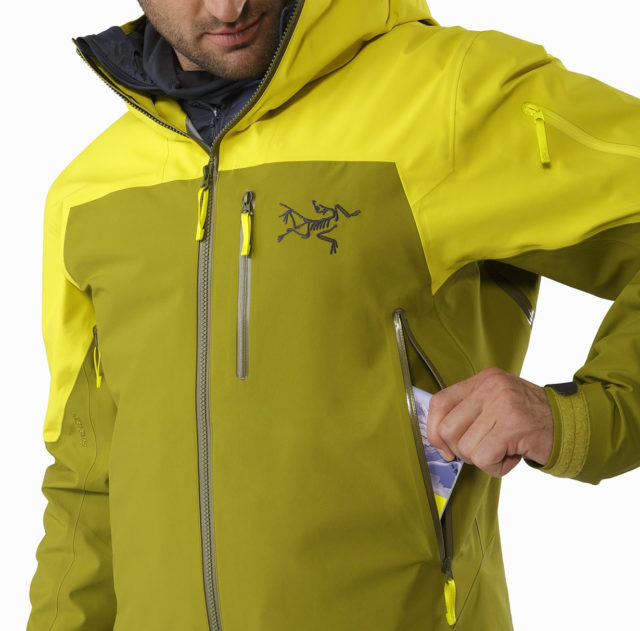
The jacket’s chest pocket is great for a phone, wallet, or snack, and the bicep pocket is a nice place to store smaller items like an RFID ski pass or chapstick.
I like having the option of an interior chest pocket as it’s often where I stash my phone or keys, and the Sabre LT Jacket’s interior chest pocket serves this purpose well. That said, for cold days, I prefer to put my phone in a pocket close to my body as it keeps the phone (and battery) warm.
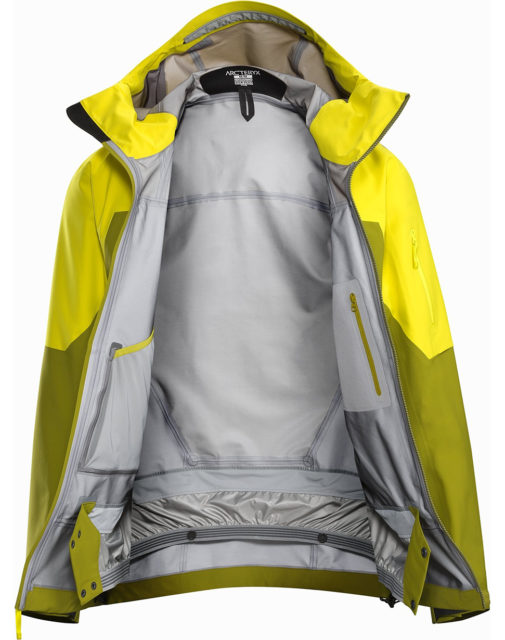
The Sabre LT Jacket’s interior drop-in pocket is a nice place to stash a pair of goggles or some wet gloves.
Hem & Hood
Beyond the pockets, the Sabre LT Jacket has adjustable cord locks at the hem and hood. The Sabre LT Jacket’s hem is pretty easy to adjust, though when using mittens, I do prefer larger, embedded cord locks like those on the Open Wear Open One 3L Shell.
Like every Arc’teryx jacket I’ve used, the Sabre LT Jacket’s hood is phenomenal. It’s big enough to easily fit over a helmet, yet I can cinch it down to comfortably fit on my bare head. And it moves pretty well with my head so that it doesn’t restrict peripheral vision.
Pit Zips
The Sabre LT Jacket’s pit zips are on the smaller side at ~35.5 cm, but their two-way zippers make it easy to open the pit zips while wearing a pack. Once opened, the Sabre LT Jacket’s pit zips do a decent job of dumping some heat, but if breathability is a top priority for you, there are plenty of better options (more on that below).
Powder Skirt
The Sabre LT Jacket has a non-removable powder skirt that works very well. The elastic at the top of the powder skirt means that I don’t really notice it while I’m wearing it, and it can attach to any of Arc’teryx’s “Whiteline” ski pants for a nearly gap-free combination. I’d prefer a removable powder skirt for days when it’s not deep, but I have had issues with the zippers on removable powder skirts breaking, so I don’t have any major complaints with the Sabre LT Jacket’s powder skirt.
Cuffs
Lastly, the Sabre LT Jacket has Velcro cuff closures. This is another thing I think Arc’teryx does really well — the Sabre LT Jacket’s Velcro cuffs are easy to use with gloves on, and the Velcro has never iced up like the cuffs on some other jackets I’ve used. And the Sabre LT Jacket’s cuffs are plenty wide so that they can easily fit over my bigger gloves and mittens.
Weight
The Sabre LT Jacket definitley isn’t the lightest shell out there, but it is fairly light and not nearly as heavy as burlier inbounds shells like the Open Wear Open One 3L Shell. To me, the Sabre LT Jacket’s weight is nice for a 50/50 shell — not so light that it sacrifices durability, but not so heavy that it feels cumbersome on the skin track.
For reference, here are a number of our measured weights for some notable jackets in this category. Note the size differences to keep things apples-to-apples.
364 g Black Diamond Helio Active Shell, size Medium
518 g Flylow Cooper Jacket, size Medium
544 g Outdoor Research Hemispheres Jacket, size Medium
563 g Rab Sharp Edge Jacket, size Medium
593 g Patagonia PowSlayer Jacket, size Large
605 g Patagonia Descensionist Jacket, size Medium
610 g Strafe Cham Jacket, size Large
626 g Arc’teryx Sabre LT Jacket, size Medium
690 g Arc’teryx Sabre Jacket (stated weight)
841 g Strafe Pyramid Jacket, size Large
848 g Open Wear Open One 3L Shell Jacket, size Medium
Materials
This is one of the main differences between the Sabre LT Jacket and the standard Sabre Jacket. The standard Sabre Jacket uses a standard 3L Gore-Tex fabric with a “lo-loft” flannel backer and 80-denier nylon face fabric.
The Sabre LT Jacket also uses a standard Gore-Tex membrane and an 80-denier nylon face fabric, but it features Gore’s much more supple C-Knit backer. The result is a much softer, quieter, and more comfortable feel. The standard Sabre Jacket can feel a bit stiff and cumbersome, but I’ve never had these issues with the Sabre LT Jacket.
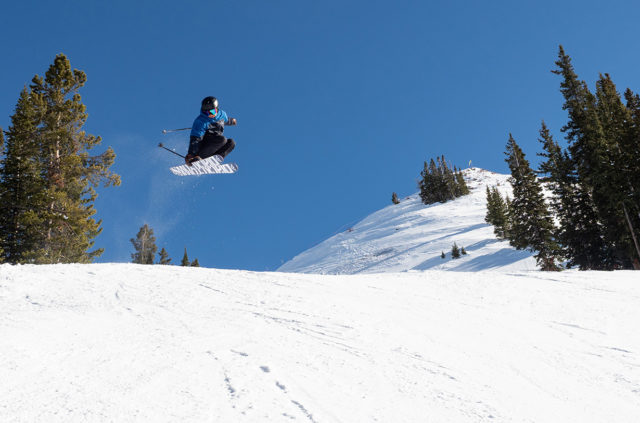
The fabric on the Sabre LT Jacket isn’t quite as soft and flexible as the fabric on the Open Wear Open One 3L Shell, Patagonia Descensionist, or Strafe Pyramid & Cham, but the Sabre LT Jacket’s fabric is step up in terms of comfort compared to stiffer, more crinkly fabrics like those on the standard Sabre and Gore-Pro shells like the Arc’teryx Alpha FL.
Weather Resistance
Like every Gore-Tex shell I’ve used, the Sabre LT Jacket does a great job of preventing water and wind from penetrating the fabric. I’ve used it in light snow, heavy, wet snow, and some rain. Through all of that, I never had any issues with water getting through the fabric from the outside.
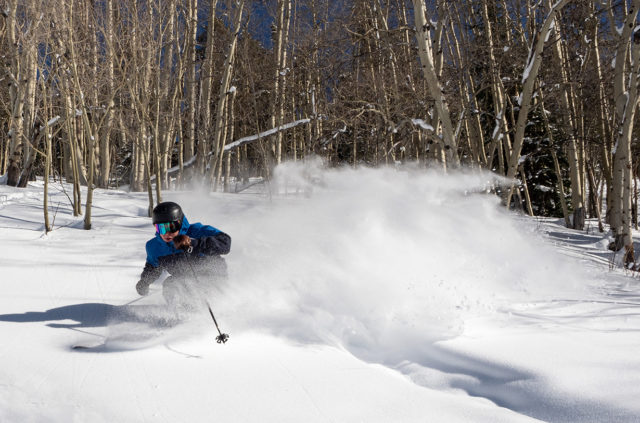
The DWR (durable water repellent finish) on the Sabre LT Jacket has worked well so far. Like every DWR I’ve used, the Sabre LT Jacket’s will bead up water for a bit in extended rain, but will ultimately stop working after extended exposure to heavy precip. So no surprises or complaints here.
Breathability
The Sabre LT Jacket falls a bit on the less-breathable end of the spectrum — it’s not as breathable as air-permeable shells like the Strafe Pyramid, Strafe Cham, Patagonia Descensionist, or Flylow Cooper, but it’s a bit more breathable than some other shells like the Open Wear Open One 3L Shell.
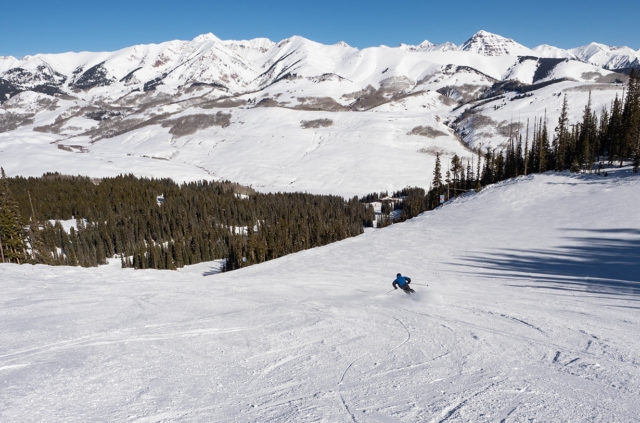
I’ve been able to comfortably skin in the Sabre LT Jacket with just a light base layer underneath in temps up to around 15°F. If it’s hotter than that or I am working very hard, I’ll toss the shell in my pack and just skin in my base layer. This is what I typically have to do with most waterproof shells, with the exception of particularly breathable pieces like the Patagonia Descensionist, Black Diamond Helio Active Shell, and Norrona Lyngen Hybrid.
So in other words, the Sabre LT Jacket breathes just as well as you’d expect a Gore-Tex shell to — not incredibly well, but not terribly, either. If maximum breathability is a priority for you, check out some air-permeable or softshell options (e.g., Strafe Cham, Patagonia Descensionist, or Norrona Lyngen Hybrid).
Warmth
Like every 3L waterproof shell I’ve used, the Sabre LT Jacket doesn’t provide much warmth at all. It’s very thin, and unlike the standard Sabre Jacket, the Sabre LT Jacket doesn’t have any sort of brushed backer fabric to add any insulative value.
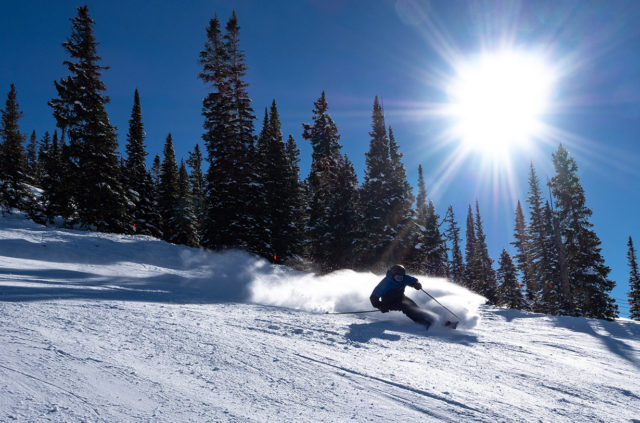
If you’re heading out in the cold, you’ll want to add some layers under the Sabre LT Jacket.
Durability
No issues here, at least after 15 days of using the Sabre LT Jacket. Its face fabric is fairly heavy, so that makes me confident about the jacket’s durability, especially compared to lighter options like the Strafe Cham, Patagonia Descensionist, and Black Diamond Helio Active Shell.
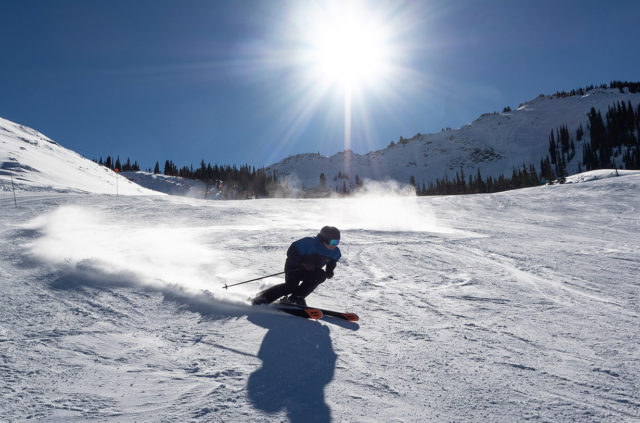
If low weight isn’t a big factor for you and you primarily want something that’s durable, the standard Sabre Jacket is a better option. Its fabric is super burly, and I’ve put that jacket through a lot without any durability issues.
I’ll keep using the Sabre LT Jacket, and will report back if any durability issues arise down the line.
Who’s It For?
Skiers and snowboarders who want a reliably waterproof shell that fits a bit on the bigger side without compromising on comfort and features.
If you’re looking for a shell that you’ll primarily use for touring in fairly dry weather, you’d be better served by a more breathable shell like the Patagonia Descensionist, Strafe Cham, or Black Diamond Helio Active Shell.
And if you’re not doing any touring and mostly want something that’s burly and has a lot of features, a heavier shell like the standard Sabre Jacket or Open Wear Open One 3L Shell could be better choices.
But if you do a bit of touring and like a lighter shell, or just want an inbounds shell that’s more comfortable than most traditional hard shells, the Sabre LT Jacket is a great option.
Bottom Line
With the Sabre LT Jacket, Arc’teryx took a well-loved jacket and made it more comfortable, lighter, and more versatile — all without seriously compromising the nice fit, features, and burly feel of the original shell. The Sabre LT Jacket’s combination of excellent weather resistance, fairly low weight, comfort, and features make it a very solid option for a lot of inbounds and backcountry skiers.

But.. How does it compares to Tantalus? Tantalus is same gore-tex, same knit-backed, even more denier (plus for inbound skiing I think). None of them is super-light ski-tour jacket. Both are knit-backed(warmer). Looks too similar to me, honestly.
The main differences between those two pieces are the fit and fabric feel. The Tantalus uses a more traditional tricot backer that makes it feel a bit stiffer and less supple than the fabric on the Sabre LT. The Sabre LT also lacks any sort of lofted, flannel-like backer, which the Tantalus does have throughout most of the jacket. The result is that the Tantalus is a bit warmer than the Sabre LT, though personally, I find the Sabre LT’s more supple fabric to be a bit more comfortable. Lastly, the Tantalus is a bit longer.
There are a number of reasons that a fabric weave with a firmer hand may be used over a more supple fabric, and I feel you are missing providing your readership with the attribute differences. Initially there is the idea of durability, and yes generally a firmer fabric provides that through thicker yarns with larger bundles of filaments, in addition it isnt just the weight of the yarns and weave but the firmer hand also helps to prevent less snagging on sharp objects such as rocks, bark, branches etc, and is more likely to shed the snag than a more supple fabric that may catch more easily. Another attribute is the DWR performance of a firmer fabric, as the simple physics of the firmer fabric sheds water and wet snow better, and tends to have a better function in climates were precip is higher and snow is warmer, the PNW for example. There is some amount of belief in the design and athlete community that with a firmer hand breathability is better, heat shedding is improved as well as warmth, as a firmer fabric can stand away from the body more readily to either provide more insulation space or vent more efficiently.
I am not saying that a firm handed fabric is better than a supple fabric only that there are attributes that each has to offer, and I think readers of Blister can relish the differences if advised on them. Of course there is just the simple fact that some people prefer the feel of wearing firmer handed fabrics and some prefer supple handed fabrics. Arc’teryx is a brand that recognizes these fine subtleties and often provides products that may appear to be quite similar but have a well targeted differences and suitability.
on the subject of fixed powder skirts versus detachable powder skirts, there are a couple detriments to the detachable powder skirt that often lead product decisions away from offering that feature; A detachable powder skirt is quite often lost or left at home when needed as opposed to being with the jacket. The zipper application creates additional stiffness and weight that may have been engineered out of the garment in all other componentry, this can be rather a conflict in design intent and the experience of the garment. Given the suppleness, fabrication selection, and engineering of the arcteryx powder skirt is second to none, it is much less noticeable then many other skirts that are more crudely fashioned with bulky heavier construction, as such it is just not as noticeable when not in use. Although this feature is called a powder skirt it might be more accurately called a “thermal skirt”, that when employed can provide keep the user at the same level of comfort warmth with a decrease of temperature 5-10 degrees F. Of course if one simply doesnt want a powder skirt at all, it is easily cut out. The attachment of the powder skirts to arcteryx bottoms is a unique piece of engineering, subtle light efficient and vastly more simple. It lacks the bulk weight and crudeness of most strap and snap solutions. Personally I feel its function and usage is far superior to any other brands, and marvel that other brands continue with less elegant solutions.
As in skis, dimensions are important, particular in quoting the length of a jacket. Although many brands do quote the length on the website, it is always worth a comparison of the actual length tested, and is a good reference in comparing from model to model and brand to brand.
How would you choose between rush and Sabre lt jacket? Sabre has additional chest pocket and slightly cheaper price but rush has better fabric. Any noticeable different if skiing with these jackets?
Looking at sabre lt versus beta sv. Hiker, not a skier. 6’2, 190. High waisted. All legs. Thanks.